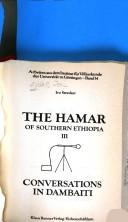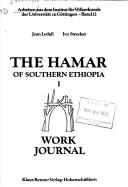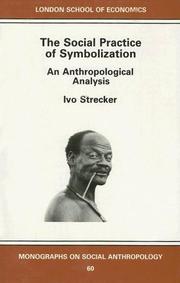| Listing 1 - 10 of 20 | << page >> |
Sort by
|

ISBN: 3876730651 Year: 1979 Publisher: Hohenschäftlarn bei München : Renner,
Abstract | Keywords | Export | Availability | Bookmark
 Loading...
Loading...Choose an application
- Reference Manager
- EndNote
- RefWorks (Direct export to RefWorks)

ISBN: 3876730635 Year: 1979 Publisher: Hohenschäftlarn bei München : Renner,
Abstract | Keywords | Export | Availability | Bookmark
 Loading...
Loading...Choose an application
- Reference Manager
- EndNote
- RefWorks (Direct export to RefWorks)
Hamar (African people) --- Hamar (Peuple d'Afrique) --- Lydall, Jean --- Strecker, Ivo A., --- Hamar (African people). --- #SBIB:39A73 --- Etnografie: Afrika

ISBN: 0485195577 Year: 1988 Volume: 60 Publisher: London : Athlone,
Abstract | Keywords | Export | Availability | Bookmark
 Loading...
Loading...Choose an application
- Reference Manager
- EndNote
- RefWorks (Direct export to RefWorks)
Hamar (African people) --- Social interaction --- Symbolic interactionism --- Hamar (Peuple d'Afrique) --- Interaction sociale --- Interactionnisme symbolique --- Social life and customs --- Moeurs et coutumes --- #SBIB:39A73 --- #SBIB:39A10 --- 316.4.052 --- -Symbolic interactionism. --- Symbolic anthropology --- Symbolism in anthropology --- Anthropology --- Interaction, Symbolic --- Interactionism, Symbolic --- Symbolic interaction --- Symbolic-interactionist theory --- Qualitative research --- Social psychology --- Human interaction --- Interaction, Social --- Exchange theory (Sociology) --- Psychology --- Amar (African people) --- Amar Koke (African people) --- Amarcocche (African people) --- Ammar (African people) --- Cocche (African people) --- Hamer (African people) --- Hamerkoke (African people) --- Hammer (African people) --- Humr (African people) --- Koke (African people) --- Nkamar (African people) --- Baggara (African people) --- Ethnology --- Etnografie: Afrika --- Antropologie: religie, riten, magie, hekserij --- Integrerende processen. Sociale controle. Sociale sancties --- Social life and customs. --- Methodology --- 316.4.052 Integrerende processen. Sociale controle. Sociale sancties
Book
Year: 1969 Publisher: Göttingen,
Abstract | Keywords | Export | Availability | Bookmark
 Loading...
Loading...Choose an application
- Reference Manager
- EndNote
- RefWorks (Direct export to RefWorks)
Book
ISBN: 9781845454630 Year: 2009 Publisher: New York Berghahn
Abstract | Keywords | Export | Availability | Bookmark
 Loading...
Loading...Choose an application
- Reference Manager
- EndNote
- RefWorks (Direct export to RefWorks)
Communication and culture --- Culture --- Language and culture --- Rhetoric --- Semiotic models
Book
ISBN: 9783825861223 3825861228 Year: 2006 Publisher: Berlin Lit
Abstract | Keywords | Export | Availability | Bookmark
 Loading...
Loading...Choose an application
- Reference Manager
- EndNote
- RefWorks (Direct export to RefWorks)
At the end of the 19th Century, southern Ethiopia was one of the last areas to experience the "Scramble for Africa", as Emperor Menelik II sent his armies south to conquer and incorporate this territory into his empire. For almost hundred years, the peoples of southern Ethiopia had to live under the highly centralised rule of the Emperor and later that of the Marxist Dergue regime, but this changed in 1991, when a new constitution was proclaimed and all barriers of class, gender, ethnic affiliation, religion and place of birth were officially abolished. But how can such a transformation to a new social order be achieved? What are its obstacles and what are its prospects? To answer this question it is indispensable to know how the culturally different peoples of Ethiopia remember their past, and what conceptions they entertain of each other. The present essays try to address this issue. In particular, they explore the dangers inherent in situations of cultural contact and examine how the powerful notions of pride, honor, name, and self-esteem come into play, as people struggle to maintain their identity, individually or as a group. The master trope for this kind of sensitivity and vulnerability in social and cultural interaction is "face". This is why the volume is entitled "The perils of face".
Social interaction --- Acculturation --- Ethnology --- Ethiopia --- History.
Book
ISBN: 9780857459350 085745935X 0857459368 1299777732 9780857459367 9781299777736 Year: 2013 Volume: 5 Publisher: New York : Berghahn Books,
Abstract | Keywords | Export | Availability | Bookmark
 Loading...
Loading...Choose an application
- Reference Manager
- EndNote
- RefWorks (Direct export to RefWorks)
All societies are shaped by arts, media, and other persuasive practices that can awe, captivate, enchant or otherwise seem to cast a spell on the audience. Likewise, scholarship itself often is driven by a sense of wonder and a willingness to be open to what lies beyond the obvious. This book broadens and deepens this perspective. Inspired by Stephen Tyler's view of ethnography as an art of evocation, international scholars from the fields of aesthetics, anthropology, and rhetoric explore the spellbinding power of elusive meanings as people experience them in daily life and while gazing at wo
Art and anthropology. --- Art and society. --- Visual anthropology. --- Visual perception. --- #SBIB:39A8 --- #SBIB:309H527 --- Optics, Psychological --- Vision --- Perception --- Visual discrimination --- Ethnology --- Art --- Art and sociology --- Society and art --- Sociology and art --- Anthropology and art --- Anthropology --- Antropologie: linguïstiek, audiovisuele cultuur, antropologie van media en representatie --- Audiovisuele communicatie: retoriek --- Psychological aspects --- Social aspects --- Art and anthropology --- Art and society --- Visual anthropology --- Visual perception
Book
ISBN: 3876730643 Year: 1979 Publisher: Hohenschäftlarn bei München : Renner,
Abstract | Keywords | Export | Availability | Bookmark
 Loading...
Loading...Choose an application
- Reference Manager
- EndNote
- RefWorks (Direct export to RefWorks)
Book
ISBN: 0857456660 1282627880 9786612627880 1845459296 0857456652 1845454634 9780857456663 9781282627888 9781845459291 Year: 2009 Publisher: New York : Berghahn Books,
Abstract | Keywords | Export | Availability | Bookmark
 Loading...
Loading...Choose an application
- Reference Manager
- EndNote
- RefWorks (Direct export to RefWorks)
While some scholars have said that there is no such thing as culture and have urged to abandon the concept altogether, the contributors to this volume overcome this impasse by understanding cultures and their representations for what they ultimately are - rhetorical constructs. These senior, international scholars explore the complex and multifarious relationships between culture and rhetoric arguing that just as rhetoric is founded in culture, culture is founded in rhetoric. This intersection of rhetoric and culture constitutes the central theme of the first part of the book, while the second
Culture --- Communication and culture. --- Language and culture. --- Rhetoric. --- Semiotic models.
Book
ISBN: 9783643903433 364390343X Year: 2013 Publisher: Zurich Lit
Abstract | Keywords | Export | Availability | Bookmark
 Loading...
Loading...Choose an application
- Reference Manager
- EndNote
- RefWorks (Direct export to RefWorks)
Hamar (African people) --- Berimba. --- Ethiopia --- History
| Listing 1 - 10 of 20 | << page >> |
Sort by
|

 Search
Search Feedback
Feedback About UniCat
About UniCat  Help
Help News
News